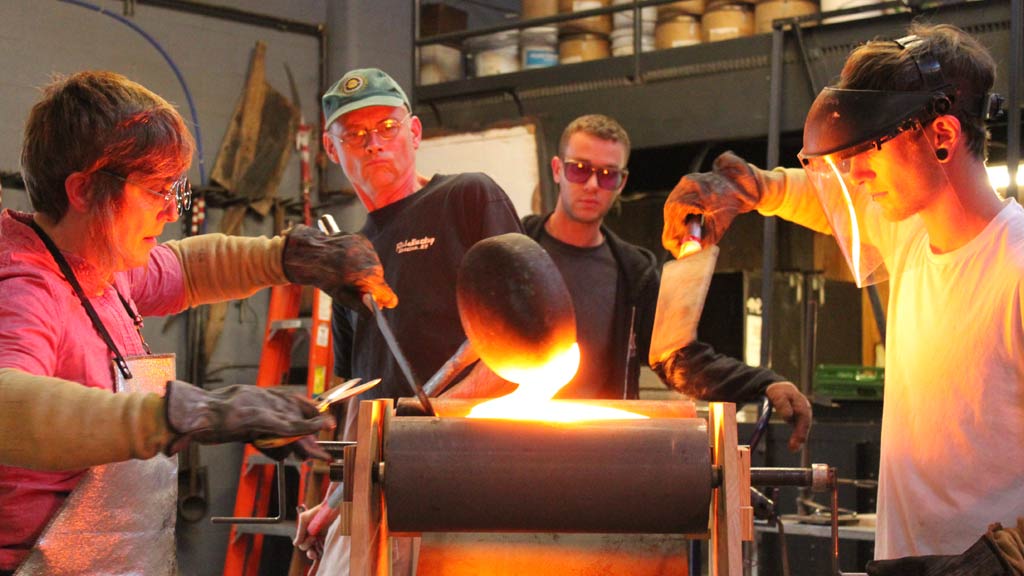Hank Adams on “Emanation: Art + Process”

Hank Adams has worked as studio creative director at WheatonArts for twelve years. As an internationally-respected artist, Hank first worked at WheatonArts (then still Wheaton Village) for a few weeks, on a commission for a homeless shelter near his home in Troy, NY. Shortly afterward, he received a fellowship residency, during which he learned more about WheatonArts and its transition from an organization heavily supported for years by the founder, Frank Wheaton Jr, and his company, Wheaton Industries…to an independent organization that has been repeatedly recognized by the NJ State Council of the Arts as one of New Jersey’s major arts institutions. Serving as a consultant after his residency, Hank provided an artist’s voice to a major strategic planning effort necessitated by Mr. Wheaton’s death and the sale of Wheaton Glass Company.
In 2004, Hank was hired as studio creative director, and he quickly activated a vision that included the expansion of the artist community to include new tiers of interns, assistants, and guest artists. He also worked to diversify the profile of artists working in the studio, to include those coming from fine art backgrounds and other media, as well as the existing pool of artists with the medium-specific references inherent in the studio glass movement. Hank’s visionary voice continues to have an impact, and is exemplified by WheatonArts’ aggressive and dynamic residency and exhibition project, “Emanation”.
In Hank’s words, “Emanation is really about expanding out into the arts community ….playing into the art world in general, which is a much more pluralistic, multimedia, and multidimensional field…… Emanation is really evidence of this institution’s very interesting and organic evolution toward an mission based on creativity, as opposed to a focus on a specific material. Glass is being used as a vehicle to make art. We’re showing the work, with the process, but it’s really about artists and where they take us.”
When asked about the participating artists’ visions, expectations, and outcomes, Hank replied:
“I think that all of these artists know that we are not known as an art museum. We’re known as a glass museum. There’s a whole set of criteria that helped with the curating. Number one, they’re good artists. Due to the nature of the process, and the learning curve typically required to work with glass successfully, we did look for artists who had some understanding of the fluidity and the mechanisms of glass, but most have not had much experience. Part of the difficulty of my job in this project is explain how glass as a medium is so intense and requires a period of research time, or in some cases, the probability of failure. So, the projects end up being in part, a collaboration, but completely informed and aligned with the artists’ vision.
A few of the artists are using our museum resources instead of the studio. Mark Dion, for instance, is making a piece that is really responsive to where we are as an institution and what we are. He’s taking some of the museum archives and some of the physical backstory of the museum and will instal the work in a spot within the historical collection that will likely offer a surprise to unsuspecting visitors. It’s a very simple idea and that’s part of its power. But it’s a very good idea and I think that we’re lucky to have him. He’s also an artist’s artist, I mean he really was very understanding of the worth, the value of this institution, and what we are as a truthful body. He’s been very responsive to that. It’s that kind of engagement and that kind of working-things-out, that to some degree each of these artists is doing.
Paula Hayes, she knows she’s not doing just glass. She doesn’t really care what medium it is, as long as it speaks to her and does what she wants.
Just the engagement with my team of artists and me, and this institution, and all of the process-ability and the layout of what is being offered here is very valuable, and they know and appreciate that. That’s where the name Emanation comes into it, because this is a sourcing point of ideas. And that’s why it’s very different than a museum installing something that was made somewhere else. This is more of a process reveal and a gestational point for these artists. That’s very unique, and very special. That’s the root of the name of the show: Emanation.”

